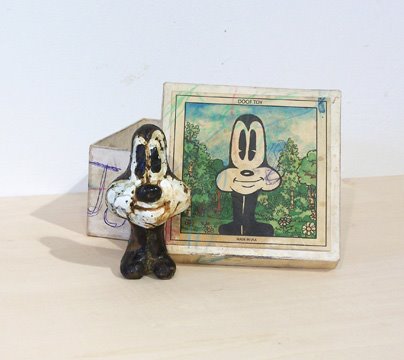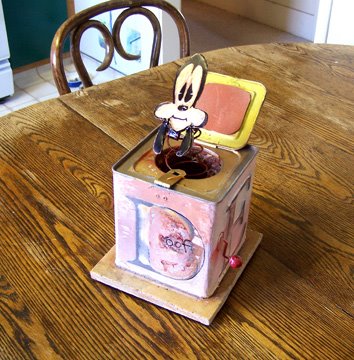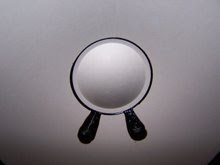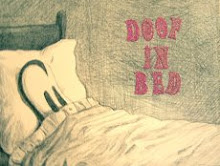
In the 1930’s and 40’s, D. Maylock (1914-1977) wrote hundreds of Doof inspired short stories for numerous dime novels published in those days . Maylock’s hard-boiled tales involved the Doof as a good luck charm that always ended in revenge and murder. He believed the cartoon image of the Doof was not based on an animal but of a spirit or entity. The Doof’s appearance, without legs, torso or arms floats above the earth supports this theory. Therefore it was easy for Maylock to infuse magic and mystery into the Doof. He imagined the Doof in his stories as an object possessing the power to grant wishes but there was a catch. Like the tale of the monkey’s paw, Doof wishes came with unexpected consequences. Doof Spiritualism had a profound influence on Maylock.
Later in life, Maylock was instrumental in helping a young Doctor Hyram Standoff, Phd. do valuable and groundbreaking research into Doof spiritualism. Dr. Standoff’s eventual book, Season of the Doof, had cause a small stir among the coffeehouse crowd with it’s paranormal theory that the Doof cartoon was much more than a rubbery cartoon. Maylock enlisted a few writing colleagues to try their hand at the genre but it was Maylock that wrote the bulk of the stories, writing under a few different pen names and for a brief period was able to flood the market with his Doof stories, in a hope that publishers would push the new genre since there was a lot of it. Maylock tried very hard to establish the Doof as a mainstream genre in pulp fiction but the market for metaphysical murder mystery dealing with enchanted art objects was limited. Eventually, fiction in the magazine industry collapsed with the advent of television. People now turned their attention to the television for their entertainment. A lot of free-lance writers became television writers. Maylock never made the transition to the little screen. Maylock eventually burnt out of ideas and found himself in the middle of a nervous breakdown. Maylock stayed away from writing and eventually found his self esteem again. He turned to writing romance novels. He translated many of the story ideas of his pulp days into his love stories and they soon became the staple among women’s book clubs across the country. This lucrative genre kept him busy for the rest of his days and he finally became a wealthy man.
Early Years
Maylock was born in the mid-west, moved to Chicago. His parents were immigrants who work in the slaughter yards. Although they spoke little english, they taught their son how to read and write and sent him to school. Maylock work in the yards on saturdays to help out his parents and would entertain the fellow workers with his suspense stories. Maylock wrote stories for the school’s newspaper and submitted stories for the english class annual. He was writing for the local paper before he finished high school. He reported news, wrote editorials and designed ads. This is where he honed in on his skills of creating stories effortlessly for a deadline. He did not have to work at the slaughter house anymore. He was making money at writing.
Maylock was inspired at an early age by a visit to the Authentic Old Drug Store and Doof Museum in Florida. There as a child he met the druggist, Dr. Wayne Fullerster who showed the lad his collection of Doofs, many old and mysterious. This visit had a huge impact on Maylock as he built his own history for the Doof. Maylock kept been corresponding with Fullerster once or twice a year trading photos, recipes, stories. Maylock visited Fullerster’s Museum on several occasions.
Pulp Writer

Maylock went into the army after high school. He stayed in the army for two years and wrote for the local army newspaper. There he meet a couple of GI’s who were in publishing before they were drafted. They liked the style of the way Maylock described things in his articles and offered him a chance to write short stories for them when his enlistment was up.
Maylock was a quiet drunkard who often was blinding drunk when he typed out story after story.Maylock was a throw back to the work ethic of filling the time with work. There wasn’t any social life. He was working for survival. It was hustle after hustle making a living. He was able to work hours on end without rest. Nobody wanted to stop him because the writing was so brilliant and concise. He would stay sober for only brief periods of time.
He developed writer’s block and this drove him to depression as the once prolific artist was empty of stories. This depression drove Maylock to having a nervous breakdown and he landed in a sanitarium to recuperate.
Later Years

Maylock married Carla Joe Zimmotto in 1967. He met her at a bar in the sanitarium and fell in love with her when she told him that she had read all that he had written. He found that he enjoyed writing again. They were together for the rest of his stay and eventually got married. After many years alone, Maylock was happy to have someone in his life. His new bride thought it would be a fresh start for her and Maylock if they cut ties with everyone he knew and move to a place in the country where Maylock could try to get back at writing. She encouraged him to write Romance novels and he easily adapted to the writing style. It wasn’t long before Maylock was busy writing novel after novel. On a summer’s night in 1977, Maylock and Carla died in an automobile accident on their 10th wedding anniversary.


























